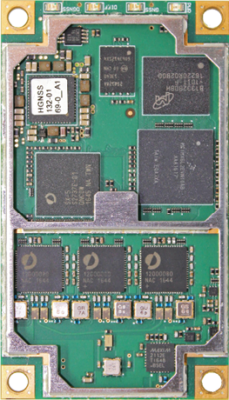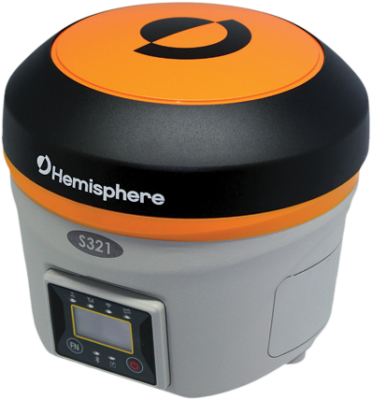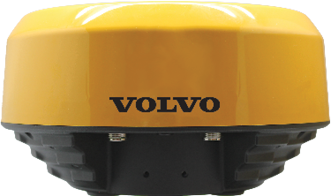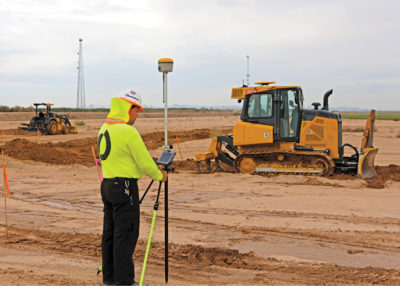
Hemisphere GNSS is headquartered in Scottsdale, AZ, USA with product development, sales, and marketing offices located around the globe.
Every time I hear the term “OEM” I think of Michael Stipe and Mike Mills, or the 80’s hit “If you leave”, and even sometimes that shock invoking SMS “initialism” that has evolved from the archaic days of flip phones. Yes, because keying in “666.6.4.” was almost as easy as just dialing the number and verbally announcing “Oooohhh myyyyy gaaaaawd, you won’t believe what just happened…” So that’s how far we’ve come as a society and OMG, Hemisphere GNSS has darn near teleported through eight years of corporate development in some sort of record breaking two year span. How did they make such a giant leap? As the saying goes, opportunity shows up at the door in work boots and overalls.
An interview with Randy Noland VP of Global Sales and Miles Ware Director of Marketing revealed how the team at Hemisphere embraced an opportunity and put the pedal to the metal! The opportunity was presented when Beijing UniStrong Science & Technology Co., Ltd. pulled Hemisphere into their global manufacturing and supply chain. Hemisphere has been manufacturing quality positioning systems for over 25 years. Although a few surveyors might not quite recognize a brand without a yellow box or “T” in the name, the Hemisphere GNSS product line has enjoyed a loyal following and great success in agriculture, marine, land survey, machine control, and, omg wait for it…the OEM market. Yes kids, there’s a good chance Hemisphere GNSS may have quietly
impacted your life in some other aspect as much as your trusty RTK rig does out on the jobsite. Actually, there’s a chance that your RTK rig was designed or built by Hemisphere. Ever heard of the Carlson Survey Brx6 GNSS survey receiver or the Stonex S10A GNSS Receiver?
So what’s the big whoop about this OEM business and what does it really mean anyway? OEM of course stands for Original Equipment Manufacturer. In the pure sense this refers to an outfit that brings raw materials into the plant and pushes some final consumer ready product out the front doors. The term has also been adapted to scenarios involving some pre-existing components hammered into something then repacked into something else that is shipped to another place and bundled with all the hardware, wires, and software that fit your market niche. The latter scenario is more likely the contemporary realization of the term. I mean let’s face it, manufacturing anything is complicated, right? It’s more efficient to get the right amount of parts made to spec by somebody else and then just bolt them into your system and season to taste, right? That seems to be how it goes, but what if there was some better way?
Hemisphere appears to be offering a better way by harnessing its three decades industrial knowledge, along with their thirty-seven awarded patents and 28 more pending, and sixty-five of the most brilliant minds in GNSS. Now remember what I said about OEM? Well, Hemisphere is and has been an OEM for decades. While we know that the definition of OEM covers a broad spectrum, Hemisphere’s needle has traditionally favored the purer sense of the definition. They actually make the guts, brains, nuts, and bolts, then provide them to the folks that shell ‘em and sell ‘em. The big news is that Hemisphere has been homogenized into Unistrong’s global fabric, a fabric woven with financial will and global industrial might. This industrial household encompasses the minds, the might, and the material to closely demonstrate the pure definition of global OEM, as well as rebranding, integration, and distribution. Quite frankly and from the industrial perspective, Hemisphere might be compared to a kid in a candy store with a world full of resources at its fingertips.

Eclipse P326 OEM Board. Powered by Hemisphere’s Athena RTK engine, the low-power module is also Atlas-capable. Atlas is a flexible and scalable positioning service, delivering its correction signals via L-band satellites at accuracies ranging from sub-meter to sub-decimeter levels.
Hemisphere has assembled an independent industrial “vertical” including everything from developing GNSS RTK algorithms, ASIC, and PCB design, to developing and manufacturing receivers and antennas, to integrating systems and software with machines, aircraft, water vessels, and vehicles. Most importantly to us rope stretchers, they are putting high quality GNSS survey systems and field/office software out on the streets of the world through the brands of Stonex, Hemisphere, and even for those good old folks on the south bank of the Ohio River, Carlson Software. Hemisphere has wrapped up the whole enchilada and is serving it over the counter.

The S321+ GNSS Smart Antenna provides robust performance and high precision in a compact and rugged package. Powered by Hemisphere’s Athena RTK engine, S321+ provides state-of-art RTK performance when receiving corrections from a static base station or network RTK correction system.
All the kids in the positioning sandbox have their own Tonka trucks and Hemisphere is moving their share of dirt. Hemisphere is a strategic partner with the Swedish outfit CPAC Systems Volva Penta, which is owned by the Volvo Group, and since 2016 is the sole source of GNSS positioning and heading systems to CPAC. Hemisphere’s GNSS technology is being used in the Dig Assist, Pave Assist, and Compact Assist solutions available in the Co-Pilot series for Volvo Construction Equipment. Worldwide, the machine control segment is integrating technologies that have captured the interest of huge global investors seeking profits through virtual management of big money construction projects. Global financial leaders and construction behemoths are embracing GNSS automation, remote sensing, and machine control as tools to wrangle out as many of the unwieldy wildcat expenses from their project investment portfolios as possible. This equates to accurate cost projections which leads to a more stable investment opportunity which ultimately reduces the risk of investing in real estate development and property management.

Hemisphere’s GNSS technology is being used in the Dig Assist, Pave Assist, and Compact Assist solutions available in the Co-Pilot series for Volvo Construction Equipment.
Being an American surveyor with a bad boundary survey habit to support, I have mentally compartmentalized the major GNSS players in the construction market. We know the names, the colors, and the great products that have resulted from this healthy competitive market.
As far as I know, or have been led to believe by a quarter century’s worth of listening to the industry’s sales reps, the corporate branding folks pick a color and market their proprietary awesome sauce in some shade of mustard, slate, seafoam, or pistachio, with the windows rolled all the way down and the subwoofer blaring. In Hemisphere’s case their color might be best described as Crayola with the volume knob set just a fuzz over a polite Canadian. This goes back to the OEM production and market branding under the Hemisphere siblings like Carlson and Stonex. While Hemisphere has its own tattoo it’s often covered up by some partner’s shirt sleeve. I suspect Hemisphere may be rolling up that sleeve and flexing their bicep to the world.
I also had the honor of chatting with Hemisphere’s Chief Technical Officer Dr. Michael Whitehead. He leads the development of advanced GNSS products, including centimeter level positioning and attitude determination systems. Dr. Whitehead gave me the rundown on two different satellite constellations. The Beidou Navigation Satellite System (BDS) is a Chinese satellite navigation system. It consists of two separate satellite constellations and is also known as COMPASS or BeiDou-2. The system became operational in China in December 2011 and has been offering services to customers in the Asia-Pacific region. An updated BeiDou-3 is evolving that will eventually consist of 35 satellites and is expected to provide global services upon completion in 2020. Beidou is ultimately projected to be more robust than the U.S. GPS constellation.

Hemisphere’s C321+ multi-GNSS, multi-frequency receiver paired with a Windows based handheld device and Hemisphere’s SiteMetrix™ field software platform is the ultimate tool to manage all of your jobsite activities.
Another system in play is The Quasi-Zenith Satellite System. QZSS is a Japanese system for regions of Asia based on a regional time transfer system and a satellite-based augmentation to the U.S. GPS, with a focus on Japanese coverage. If it takes an intelligent mind to understand and decode the systems, it further takes a brilliant mind to cook it all down and serve it to a rod jockey like me. Dr. Whitehead truly is that down to earth Einstein and chats about this logic as if it were a bundle of hubs or a roll of flagging. So, putting the constellation in an everyday perspective we can get a glimpse of the past present and future. Twenty years ago every garage only had one American car in it, GPS. Then the Russians sold us a really great tractor, GLONASS and we parked her in there too. The Europeans crafted a fancy motorcycle and we made room for Galileo, the Japanese are pulling in a fuel efficient hybrid sedan with QZSS, and the Chinese are showing up with what appears to be a bad mamba jamba monster truck with Beidou. Yeah, after 25 years we, the consumer, have a four car garage full of the biggest, baddest, best-est, measuring systems the world has ever seen.
So, it’s football season and we’ll all be glued to the NCAA rankings. I’m not sure how our GNSS product manufacturers get rated but after my chat with the Hemisphere folks I’m starting to think Hemisphere is more like the NCAA itself rather than any particular Big 10 Team. Hemisphere envisions exciting industrial changes rapidly redefining the scenery of the ultra-competitive GNSS positioning market. ◾


